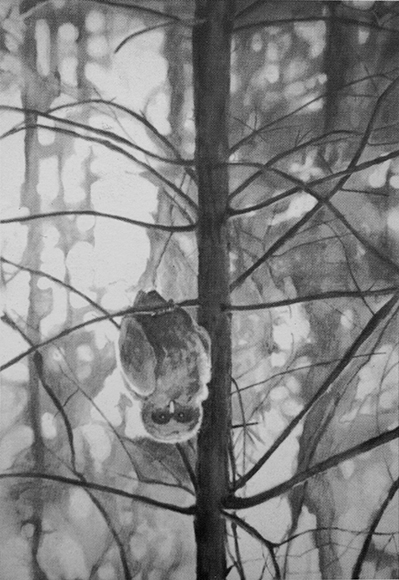
Isidora Laban, When I Was On Safari In ‘77, oil on canvas, 1998.
In the theatre play Art (Yasmina Reza, 1994), three friends confront their ideas of art and life over a white painting, and ‘demystify’ it in various ways: by pushing and shoving it around the stage, laughing at it, pronouncing it worthless, and finally drawing on it – to the true joy of the audience. The only reaction, however, that this play provokes in an educated spectator is a temptation to replace the suffering prop with one of Robert Ryman’s white paintings. The almost certain lack of any reaction from both the actors and the audience would remind us of how remote our world is from art, and point to the idea that only the simulation of art is acceptable for the general audience. As the matter of fact, Art confirms this idea even without any intervention. Behind its faint critique, this play quite cynically indulges the profane belief that art has become superficial and remote, turning into a hermetic and incomprehensible world apart. The disparity between the world and art is, nevertheless, art’s essential prerequisite, and Art in fact expresses an ignorant fear and rejection of art.
Observed with its audience, this play ceases to be a parody of art (consumption) and turns into a parody of the world in which and for which it was created, the world in which human identity has become trivial and transparent, turning into its own derisive imitation. Far more superior than in Art (and in theatre), parody is excercised by the recent Hollywood productions that subtly subvert almost everything, from dramatic structure (Lost Highway), form (From Dusk Till Dawn), through morality (Falling Down, American Beauty), eroticism and emotions (Crash), to the film’s very medium (Natural Born Killers) and ideology (The Faculty). The strategies for evading various forms of censorship are, however, often highly sophisticated and the parody that makes it to the screen becomes so subtle that it is difficult to find its target and, actually, to be certain that the very directorial effort avoided becoming a parody of elusive creativity. One film that uses parody without such restraint is I.D. (1995) but its director Philip Davis is British which is not accidental, because British culture leads the way in the contemporary identity crisis. The current British cultural scene is overwhelmed with a frenetic offer of diverse choices and lifestyles that long ago lost their creative momentum and turned into the market options (which maybe could explain, but certainly not justify, Yasmina Reza’s motivation). This cultural environment fosters a refined visual art that oscillates between (æsthetic) nihilism and decoration, extravagance and numb obscurity, neo-academism and consumerism. One of the seemingly paradoxical effects of this identity crisis is the tacit lack of approval for anything that cannot be perceived, discussed and incorporated as ‘British’. This forces many foreign young artists to adjust their own poetics and styles to somehow match the local themes, techniques or ‘looks’.
Unburdened with the need for this kind of recognition (and social scheming), Isidora Laban is a painter whose only connection with Great Britain is the fact that she lives there. That sets her among the few artists whose poetics linger on the edge of acceptability but who are still regarded by the local cultural establishment, (although this is probably more due to the artist’s personal authority than the true appreciation). While the theatrical atmosphere of her still lives (In the Garden, On the Square, Night on the Square, Two Bags) brings homage to Watteau, it introduces quite unconventional treatment of its ‘actors’. The empty plastic bottles become passers-by, and shopping bags turn into lovers. These protagonists are ridiculous and senseless, but they are far more adequate for the identification of any serious audience than the theatre actors. Thoroughly worked-out in paint, the study of their characters is much more relevant than the equivalent theatre setting could ever be. Here, the visual and reflexive levels merge in a seductive dance of mutual masking and unveiling that reaffirms the non-verbal character of dynamics and ambience. In a similar way, the series Choose Your Own Deserted Beach are more than ordinary landscapes even though they represent the world of Nature with which the artist is engaged in a magic visceral interchange. The code of that interchange is, however, very specific because the painted vistas are taken from the idiotic, mass-distributed tourist brochures. These paintings haunt the viewer with the unpleasant fusion of attraction and repulsion, demanding contemplation that cannot be articulated only by rational assessment implied in parody.
In the visually and conceptually most complex series When I Was On Safari In ‘77, the memento mori delivers life as well as death with disturbing calmness. The risks undertaken in these pictures are the results of brave assessment of an author who equally employs her strenghts and her weaknesses. This series discreetly affirms the key faculty of art that, taming and transcending the greatest horrors, purifies the experience of the world.
The theatricality and parody in Isidora Laban’s paintings play the complex allegorical role of understating their truly abstract nature which (like in Ryman) brings about the contemplation of the very process of painting. Like strokes in Ryman, the works of Isidora Laban can be regarded as visual mantras whose repeating humming brings the viewer to the unwelcoming secret of self-realisation.
Isidora laban, Choose Your Own Deserted Beach, exhibition catalogue, Faculty of Fine Arts Gallery, Belgrade, 1999.